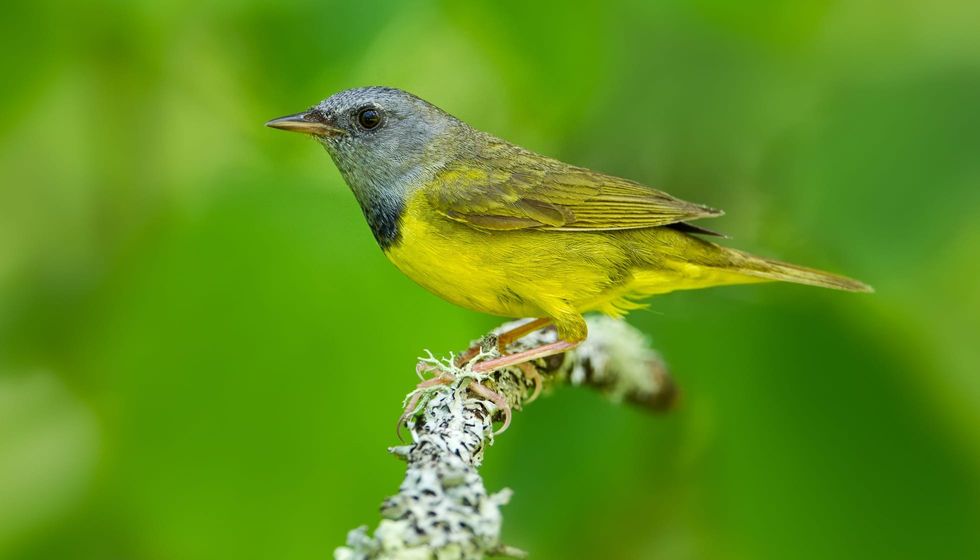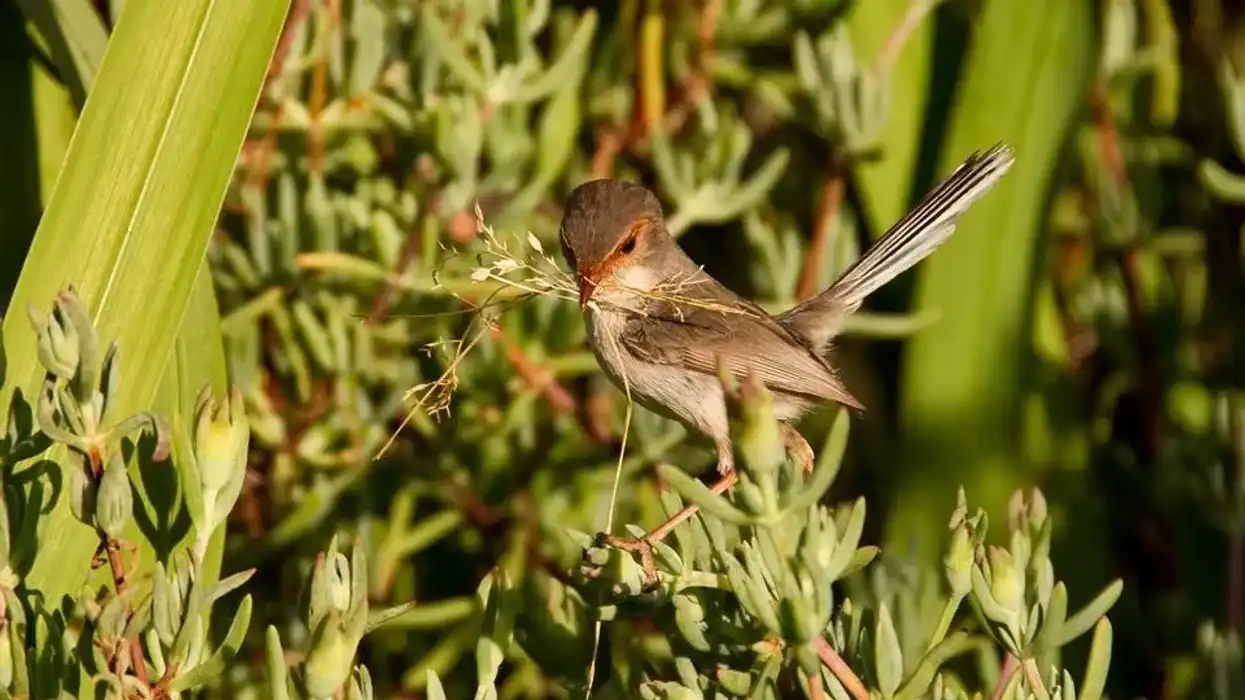A mourning warbler (Geothlypis philadelphia) is a species of bird that is famously hailed as a songbird from the regions of North and South America, Canada, and several other adjoining places. This bird can be distinguished from other similar species of warblers by their exceptional appearance.
This species derived its name from its appearance as well. Male members of the family come with a dark black patch on their throat which is why the word 'mourning' (often associated with the color black) has been attributed to their name.
An interesting behavior of this species is that after laying the eggs, males and females indulge in pretentious moves in the presence of their predators where they act as if they are hurt or injured. In this manner, they guile the predators by distracting them.
The bird is known to survive in areas of regrowth which thanks to conservation is not yet threatened. However, surveys have shown a steady decline in the population of this species.
If you enjoyed these exciting facts about mourning warblers, then you can also check out some more interesting facts about other bird species like the chestnut-sided warbler and Blackburnian warbler.
Mourning Warbler Interesting Facts
What type of animal is a mourning warbler?
A mourning warbler is a species of bird of order Passeriformes and the family Parulidae.
What class of animal does a mourning warbler belong to?
Mourning warblers belong to the class Aves.
How many mourning warblers are there in the world?
The exact number of mourning warblers is difficult to assess owing to the inadequate records and computations of the adult bird population. However, although these birds, belonging to the order Passeriforme and the family Parulidae, are not considered to be vulnerable, their population has been declining slowly.
Where does a mourning warbler live?
This species of mourning warblers is originally from several parts of North America as well as Central America. They are also found specifically in places like Canada, South America, Guatemala, Puerto Rico, and Belize.
What is a mourning warbler's habitat?
These birds are mainly constricted to the forest habitat, especially areas with new regrowth caused by disturbances such as construction work, mining, and agriculture. A habitat comprising shrubs and dense thickets serves as ideal spots. Sometimes in their native habitat, this bird species flap their wings to distract predators.
Who do mourning warblers live with?
This species of mourning warblers are solitary birds. Even during migration, these birds prefer to avoid flocking.
How long does a mourning warbler live?
Mourning warblers normally have a life expectancy of seven to eight years in the wild.
How do they reproduce?
Since North American mourning warblers are difficult to locate, their exact behavior during breeding is unknown. Their nest is built at a very low level and the clutch consists of two to five eggs.
After the breeding process is completed, both males and females incubate, protect the nest from predators, and take care of the hatchlings until they can feed themselves.
What is their conservation status?
The conservation status of a mourning warbler falls under the category of Least Concern in the IUCN Red List of Threatened Species. The birds are very common in several parts of America. However, the population trend of the species shows a steady decline.
Mourning Warbler Fun Facts
What do mourning warblers look like?
This species can be identified by their appearance. A male usually has a yellow and olive-colored body. They have a black chest as well as a gray hood, but a mourning warbler female comes in a dull gray-brownish color. They have a small beak, long tail, and sturdy feet.

*Please note that this is an image of A Myrtle Warbler, not Mourning Warbler. If you have an image of Mourning Warbler please let us know at hello@kidadl.com.
How cute are they?
These birds are bright and beautiful. They might not exactly be defined as cute, but they are undoubtedly attractive. Their breeding and nest building also might be an area of intrigue.
How do they communicate?
This bird of the Parulidae family communicates by making distinct calls which include repetitive and churning sounds like 'chorry-chorry', 'teedle-teedle', 'chew-chew', and 'tsip'. Even if you are not able to see this bird hiding in the thickets of the forest, you will definitely identify its song. A mourning warbler song is extremely soothing to the ears.
How big is a mourning warbler?
On average, mourning warblers are small birds ranging from 3.9-5.9 in (10-15 cm) in length. They are larger than the goldcrest with a length of around 3.3-3.7 in (8.3-9.3 cm).
How fast can a mourning warbler fly?
Mourning warblers show high amounts of agility and swiftness during flight. The speed limit is unknown and is yet to be ascertained.
How much does a mourning warbler weigh?
The weight of a mourning warbler ranges from 0.4-0.5 oz (11-13 g).
What are their male and female names of the species?
Neither genders of the bird species have a special name. They are referred to as female and male mourning warblers, respectively.
What would you call a baby mourning warbler?
A baby mourning warbler is generally called a 'hatchling' or 'nestling'.
What do they eat?
These birds are known to be entomophagous which implies that the diet of mourning warblers primarily comprises different types of insects. Spiders, beetles, caterpillars, and even berries comprise the diet of these North American birds. These birds normally limit their foraging to a maximum range of 10 ft (30.5 cm) above the surface.
Are they dangerous?
Mourning warblers are generally not known to be aggressive in nature. In the wilderness, apart from preying on various types of insects, these birds are gentle and quite self-contained.
Would they make a good pet?
It is unknown if these birds make good pets as mourning warblers are not commonly reared as pets. They are wild birds and must not be encaged.
Did you know...
A mourning warbler (Geothlypis philadelphia), also scientifically termed as Oporornis philadelphia, uses its wings to distract predators.
These birds remain close to the ground, often hopping about here and there foraging for food in the dense thickets. Even during the breeding season, this bird builds its nest at a low height. For this reason, they are very difficult to trace.
Mourning warblers sometimes follow ant trails and snatch away the insects manoeuvred by them.
Fall and spring are the seasons when this species of mourning warblers migrate.
What does a mourning warbler's call sound like?
These North American birds make several types of calls that distinctly include the primary call and the flight call, along with other sounds and calls. The rolling and rhythmic 'churry-churry-churry' is the primary call where each following sound gradually escalates to a higher pitch. The flight calls sound somewhat identical, but the notes alter with more swiftness and rapidity.
How does a mourning warbler compare to other warblers?
This species has been named warblers due to their singing or warbling potentialities. The term 'warbler' finds its roots in Old French, where the word denotes singing 'with trills and quavers'.
How do you identify different warblers?
Warblers consist of several similar species. Nevertheless, they come with some minute distinctions. For instance, a male Connecticut warbler possesses a wider eye-ring that surrounds its entire eyes while the eye-ring of a female or an immature mourning warbler is much thinner.
Moreover, females have a lighter shade of white in their throat region, while the Connecticut warbler has a darker shade of gray. Another similar species is the MacGillivray's warbler. A MacGillivray's warbler has white crescents around its eyes that is uncommon in other species.
Here at Kidadl, we have carefully created lots of interesting family-friendly animal facts for everyone to discover! Learn more about some other birds including Palm warbler, or pine warbler.
You can even occupy yourself at home by drawing one on our Mourning Warbler coloring pages.










